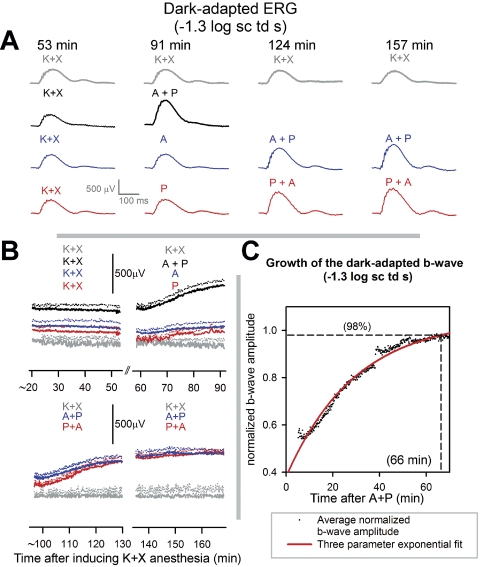Figure 2.
Time course of effects of mydriatics on the dark-adapted ERG of anesthetized mice: (A, gray traces) dark-adapted ERG of a single mouse recorded at 53, 91, 124, and 157 minutes after induction of anesthesia in response to flashes of −1.3 log sc td s. Black traces: dark-adapted ERG in response to flashes of −1.3 log sc td s for a single mouse at distinct time intervals. K+X: 53 minutes after induction of anesthesia; A+P: 91 minutes after induction of anesthesia and 38 minutes after instillation of topical A+P. Blue traces: dark-adapted ERG in response to flashes of −1.3 log sc td s for a single mouse at distinct time intervals. K+X: 53 minutes after induction of anesthesia; A: 91 minutes after induction of anesthesia and 38 minutes after instillation of topical A; A+P (left): 124 minutes after induction of anesthesia, 76 minutes after instillation of topical A, and 38 minutes after instillation of topical A+P. A+P (right): 157 minutes after induction of anesthesia, 109 minutes after instillation of topical A, and 71 minutes after instillation of topical A+P. Red traces: dark-adapted ERG in response to flashes of −1.3 log sc td s for a single mouse at distinct time intervals. K+X: 53 minutes after induction of anesthesia; P: 91 minutes after induction of anesthesia and 38 minutes after instillation of topical P; P+A (left): 124 minutes after induction of anesthesia, 76 minutes after instillation of topical P, and 38 minutes after instillation of topical A+P. P+A (right): 157 minutes after induction of anesthesia, 109 minutes after instillation of topical P, and 71 minutes after instillation of topical A+P. (B) Time course of change in dark-adapted b-wave amplitude (−1.3 log sc td s) after induction of K+X anesthesia. Each colored trace represents the same set of animals under observation after receiving K+X anesthesia, with or without mydriatics. The different data sets are offset vertically from one another, as the initial baselines for all them are indistinguishable. Gray traces, top and bottom: average b-wave amplitude of the dark-adapted ERG of three animals after K+X anesthesia. Black traces (n = 3), top: K+X: average b-wave amplitude since K+X anesthesia; A+P: average b-wave amplitude after administration of topical A+P after 54 minutes of K+X anesthesia. Blue traces (n = 3), top: K+X: average b-wave amplitude since K+X anesthesia; A: average b-wave amplitude after administration of topical A after 54 minutes of K+X anesthesia; bottom: A+P (left), average b-wave amplitude after topical A+P administered after 92 minutes of K+X anesthesia (39 minutes after A); A+P (right), traces continued from A+P (left). Red traces (n = 4), top: K+X, average b-wave amplitude since K+X anesthesia; P, average b-wave amplitude after administration of topical P after 54 minutes of K+X anesthesia; bottom: P+A (left), average b-wave amplitude after topical A+P administered after 92 minutes of K+X anesthesia (after 39 minutes after A); P+A (right), traces continued from A+P (left). Dotted lines: +1 SEM. (C) Time course of growth of the b-wave amplitude after coapplication of A+P. Dots: averaged b-wave amplitude (n = 7) normalized to the b-wave Vmax (data from Fig. 2B, red and blue traces, bottom). Dots were fitted with an exponential with a time constant of 29.7 minutes (gray curve). Horizontal dashed line: 98% saturation of the fitted function, which corresponded to a time of 66 minutes after application of A+P (vertical dashed line).

